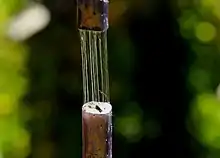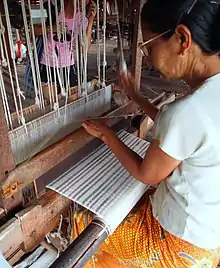Lotus silk
Lotus silk (Burmese: ပိုးကြာချည် or Burmese: ကြာချည်, lit. 'lotus thread') is a type of textile produced using delicate lotus stem fibers. The fabric first originated in Myanmar (Burma), and is now also woven by smaller-scale cottage industries in Vietnam.[1][2] Due to the complexity and labor-intensive nature of weaving lotus fibers, lotus silk is considered one of the most expensive fabrics in the world.[1][3]


Burmese lotus silk uses fibres from a specific variety of lotus called padonma kya (ပဒုမ္မာကြာ), which produces large, fragrant pink flowers.[4] The lotus stems are sourced from Shan State's Inle Lake, and throughout Myanmar, including Mandalay Region (Sunye Lake in Sintkaing Township); Bago Region (Inma Lake in Thegon Township); Magway Region (Wetthe and Salin Natural Lakes in Salin Township); Sagaing Region (Kandaunggyi Lake in Taze Township).[4]
History

Lotus silk weaving originated in Inle Lake in Myanmar's Shan State. Lotus weaving was invented by an ethnic Intha woman named Sa Oo in the village of Kyaingkhan in the early 1900s.[5][4] She first wove a Buddhist monastic robe using lotus fibers, called kya thingan (ကြာသင်္ကန်း), as an offering to the abbot of a local monastery, and offered similar monastic robes to the principal Buddha images at Phaung Taw Oo Pagoda.[4] The tradition of robe-weaving has a long history in Myanmar; during the Tazaungdaing festival, robe-weaving competitions are held throughout major Burmese pagodas.

The weaving practice went extinct after her death, and was subsequently revived by her relatives, Tun Yee and Ohn Kyi, who began a cooperative to modernize and systematize the weaving practice.[4]
In 2017, Phan Thi Thuan, a weaver near Hanoi, introduced the weaving practice to Vietnam.[2]
Uses
.jpg.webp)
Lotus silk was first used to weave monastic robes as an offering to Buddha images or Buddhist monks, but is now also used for a variety of clothing types, including scarves and hats.[4] Loro Piana, a luxury clothing company, has imported Burmese lotus silk to produce jackets and other clothing products since 2010.[6]
References
- Floyd, Charlie. "Lotus silk is one of the rarest fabrics in the world, but what makes it so expensive?". Business Insider. Retrieved 2021-01-05.
- "Fabric of Success: How 'Lotus Silk' Is Weaving Its Way Into Vietnam". Agence France-Presse. 2020-08-28. Retrieved 2021-01-05.
- Win, Lei Lei. "Lotus weaving". The Encyclopedia of Crafts in WCC-Asia Pacific Region (EC-APR). Retrieved 2021-01-06.
- Theingi Myint; Khin Nyein San; Aung Phyo (2018). Lotus Fiber Value Chain in Myanmar (PDF). Regional BioTrade Project.
- Chaw Su Hlaing (2016). "Lotus Robe in Kyaing Khan Village Innlay Lake, Shan State (South): An Anthropological Perspective" (PDF). Dagon University Research Journal. 7: 91–102.
- Binkley, Christina (2010-11-03). "New Luxury Frontier: A $5,600 Lotus Jacket". Wall Street Journal. ISSN 0099-9660. Retrieved 2021-01-06.
